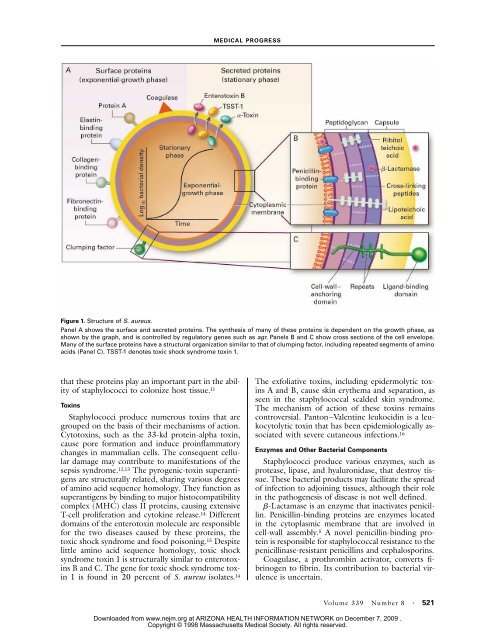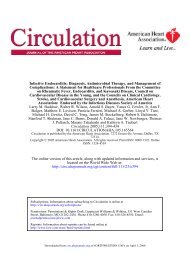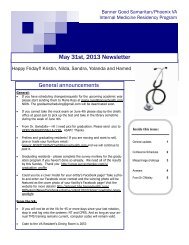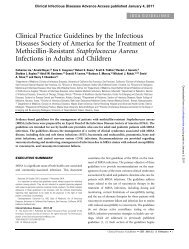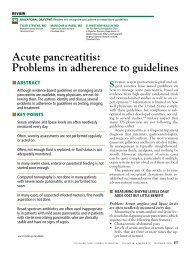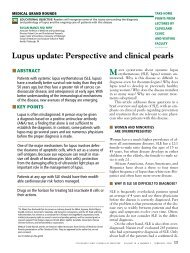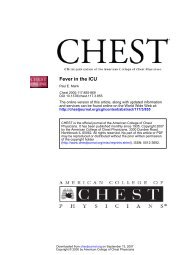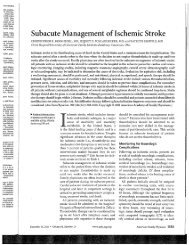082098 Staphylococcus aureus Infections - Goodsamim.com
082098 Staphylococcus aureus Infections - Goodsamim.com
082098 Staphylococcus aureus Infections - Goodsamim.com
You also want an ePaper? Increase the reach of your titles
YUMPU automatically turns print PDFs into web optimized ePapers that Google loves.
MEDICAL PROGRESS<br />
Figure 1. Structure of S. <strong>aureus</strong>.<br />
Panel A shows the surface and secreted proteins. The synthesis of many of these proteins is dependent on the growth phase, as<br />
shown by the graph, and is controlled by regulatory genes such as agr. Panels B and C show cross sections of the cell envelope.<br />
Many of the surface proteins have a structural organization similar to that of clumping factor, including repeated segments of amino<br />
acids (Panel C). TSST-1 denotes toxic shock syndrome toxin 1.<br />
that these proteins play an important part in the ability<br />
of staphylococci to colonize host tissue. 11<br />
Toxins<br />
Staphylococci produce numerous toxins that are<br />
grouped on the basis of their mechanisms of action.<br />
Cytotoxins, such as the 33-kd protein-alpha toxin,<br />
cause pore formation and induce proinflammatory<br />
changes in mammalian cells. The consequent cellular<br />
damage may contribute to manifestations of the<br />
sepsis syndrome. 12,13 The pyrogenic-toxin superantigens<br />
are structurally related, sharing various degrees<br />
of amino acid sequence homology. They function as<br />
superantigens by binding to major histo<strong>com</strong>patibility<br />
<strong>com</strong>plex (MHC) class II proteins, causing extensive<br />
T-cell proliferation and cytokine release. 14 Different<br />
domains of the enterotoxin molecule are responsible<br />
for the two diseases caused by these proteins, the<br />
toxic shock syndrome and food poisoning. 15 Despite<br />
little amino acid sequence homology, toxic shock<br />
syndrome toxin 1 is structurally similar to enterotoxins<br />
B and C. The gene for toxic shock syndrome toxin<br />
1 is found in 20 percent of S. <strong>aureus</strong> isolates. 14<br />
The exfoliative toxins, including epidermolytic toxins<br />
A and B, cause skin erythema and separation, as<br />
seen in the staphylococcal scalded skin syndrome.<br />
The mechanism of action of these toxins remains<br />
controversial. Panton–Valentine leukocidin is a leukocytolytic<br />
toxin that has been epidemiologically associated<br />
with severe cutaneous infections. 16<br />
Enzymes and Other Bacterial Components<br />
Staphylococci produce various enzymes, such as<br />
protease, lipase, and hyaluronidase, that destroy tissue.<br />
These bacterial products may facilitate the spread<br />
of infection to adjoining tissues, although their role<br />
in the pathogenesis of disease is not well defined.<br />
b-Lactamase is an enzyme that inactivates penicillin.<br />
Penicillin-binding proteins are enzymes located<br />
in the cytoplasmic membrane that are involved in<br />
cell-wall assembly. 5 A novel penicillin-binding protein<br />
is responsible for staphylococcal resistance to the<br />
penicillinase-resistant penicillins and cephalosporins.<br />
Coagulase, a prothrombin activator, converts fibrinogen<br />
to fibrin. Its contribution to bacterial virulence<br />
is uncertain.<br />
Volume 339 Number 8 · 521<br />
Downloaded from www.nejm.org at ARIZONA HEALTH INFORMATION NETWORK on December 7, 2009 .<br />
Copyright © 1998 Massachusetts Medical Society. All rights reserved.


